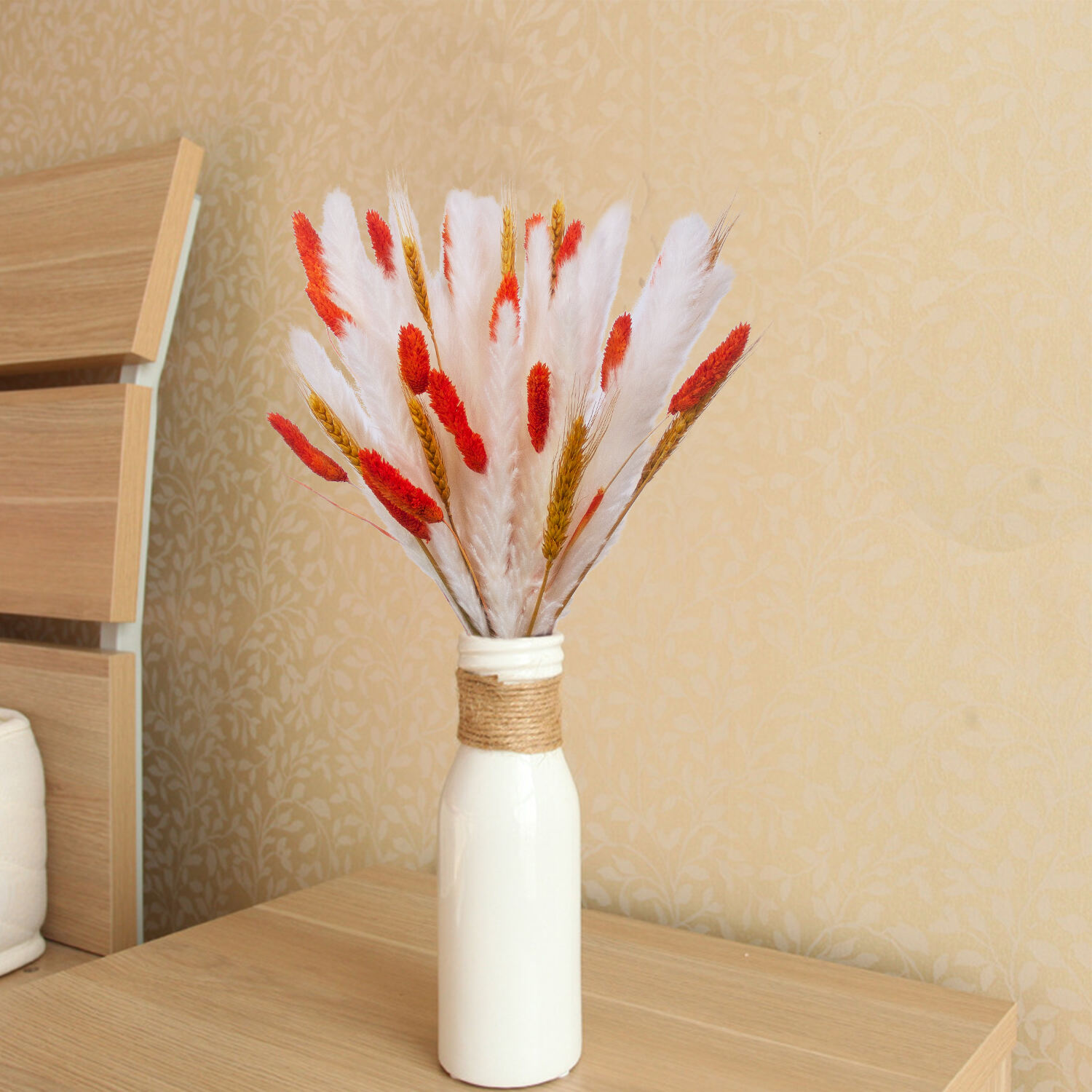
Prozkoumejte náš rozsáhlý výběr sušených květin velkoobchodně včetně pampasové trávy a konzervovaných růží. Naše konzervované květiny jsou ideální pro vytváření ohromujících aranžmá, která krásně vydrží v jakémkoli prostředí.
Tradiční distribuce řezaných květin skrývá několik doposud nepostihnutelných ekologických nákladů, zejména ve vztahu k dopravě. Alarmující je, že přibližně 70 % dovozovaných květin se dopravuje letecky, což je metoda známá vysokou úrovní emisí CO2. Takovéto dopravní praktiky výrazně přispívají ke zvyšování celkových emisí skleníkových plynů a tudíž zpochybňují obecnou představu o květinách jako o produktu nevinném pro životní prostředí. Ekologická stopa sahá dál než jen po emise; zahrnuje i vyčerpávání zdrojů během výroby květin, například spotřebu vody, která může ohrožovat lokální dodávky, a použití pesticidů, které ohrožují biodiverzitu. Všechny tyto faktory dohromady zdůrazňují naléhavost přehodnocení a transformace dodavatelských řetězců květin s cílem zmírnit tyto skryté ekologické náklady. Přechodem k udržitelnějším modelům můžeme těchto dopadů výrazně zredukovat.
Statistiky odpadu ve květinářském průmyslu zdůrazňují naléhavou potřebu udržitelných postupů. Je šokující zjistit, že téměř 30 % řezaných květin se nepromane a skončí nakonec vyřazených, což způsobuje významný odpad. Světový fond na ochranu divoké přírody (WWF) vyzývá zúčastněné subjekty průmyslu, aby přijaly udržitelné postupy a omezily odpad způsobovaný květinářským průmyslem a bojovaly proti ekologické degradaci. Tato výzva je tím naléhavější, vzhledem k odhadované hodnotě květinářského průmyslu na zhruba 35 miliard dolarů. Jak ekonomické, tak i environmentální náklady odpadu vyžadují zásadní reformy. Přijetím udržitelnosti prostřednictvím inovací, jako jsou sušené květiny a kompozice z udržených květin, mohou floristé omezit odpad a podporovat více ekologicky zodpovědný přístup v rámci průmyslu.
Suché květinové aranžmá mají v porovnání s čerstvými květinami výrazně delší trvanlivost. Zatímco čerstvé květiny vydrží týden nebo dva, suchá květinová aranžmá odolají zkoušce času a mohou trvat několik měsíců až let. Tato prodloužená životnost z nich činí ekonomicky výhodnou volbu pro velkoobchodníky, kteří chtějí oslovit ekologicky uvědomělé zákazníky a firmy odpovědné k životnímu prostředí. Proces konzervace používaný u sušených květin minimalizuje potřebu častých výměn, což snižuje náklady a výrazně také ekologickou stopu spojenou s výrobou a odpadem květin.
Uchování květin hraje klíčovou roli při snižování emisí uhlíku v průmyslu. Oproti čerstvým květinám vyžadují konzervované květiny méně energie na výrobu a dopravu, čímž lze výrazně snížit emise CO2. Studie ukazují, že velkoobchodníci mohou snížit svou uhlíkovou stopu až o 60 % přechodem z čerstvých květin na sušené a konzervované alternativy. Toto opatření odpovídá širším zásadám udržitelnosti a nejenže pomáhá životnímu prostředí, ale také posiluje pověst podniků mezi ekologicky uvědomělými zákazníky. Přijetí těchto postupů signalizuje závazek k udržitelnosti, čímž se zvyšuje atraktivita značky a věrnost zákazníků na rychle se měnícím trhu zaměřeném na ekologická řešení.
Zaměření na etické zdroje je klíčové pro velkoobchodníky, kteří chtějí nabízet ekologicky přípustné sušené květiny. Začíná to výběrem dodavatelů, kteří dodržují udržitelné zemědělské postupy, včetně spravedlivých pracovních podmínek a minimálního používání chemikálií. Tyto postupy nejenže chrání ekosystém, ale také zajistí ochranu pracovníků a komunit zapojených do výroby. Spolupráce s certifikovanými udržitelnými farmami posiluje důvěru spotřebitelů, kteří stále více hodnotí udržitelnost produktů, které kupují. Tím, že velkoobchodníci nakupují květiny z etických zdrojů, se mohou přizpůsobit hodnotám ekologicky uvědomělých zákazníků a podporovat dlouhodobou loajálnost zákazníků.
Zavedení strategií obalování bez odpadu u velkoskladních dodávek sušených květin je efektivním krokem ke snížení zátěže na životní prostředí. Inovativní obalová řešení, jako je použití kompostovatelných materiálů, pomáhají minimalizovat odpady a posilují ekologický image květinářských produktů. Tyto udržitelné metody balení nepodporují pouze environmentální cíle, ale také oslovují zákazníky, kteří při nákupních rozhodnutích kladejí důraz na udržitelnost. Zavedením těchto postupů nejen velkoobchodníci naplňují očekávání zákazníků, ale také přispívají k nastavení nových odvětvových standardů. S rostoucí poptávkou po ekologických alternativách se stává soulad podnikatelských operací s udržitelným balením konkurenční výhodou.
Vedoucí hotelový řetězec přistoupil k udržitelnosti inovativním způsobem, a to tím, že začlenil konzervované květinové aranže do svého celoročního dekoru. Tento strategický krok nejen minimalizuje odpad, ale také zvyšuje úroveň prostředí díky okouzlujícím, trvanlivým centrálním prvkům. Mnozí hosté upozornili na preferenci těchto ekologicky šetrných opatření, čímž se podpořila větší zákaznická loajalita a posílila pověst značky v oblasti udržitelnosti. Kromě toho tento posun zdůrazňuje důležitý trend v hotelovém průmyslu směřující k propojení ekologické estetiky.
Organizátoři svateb se stále častěji uchylují k programům velkoobchodu s výrobky z vyžlechtěných květin, aby uspokojili rostoucí poptávku po ekologických svatbách. Přechod na kytice z vyžlechtěných květin poskytuje organizátorům příležitost nabídnout nevěstám a ženichům jedinečné a trvanlivé alternativy, které výrazně snižují množství odpadu. Narůstající zájem o kompozice z vyžlechtěných květin odhaluje pozoruhodný trend v květinářském průmyslu, což naznačuje změnu preferencí zákazníků směrem k udržitelnosti. S rozvojem tohoto oboru se otevírá prostora pro to, aby se organizátoři svateb zaradili do řady služeb v souladu s ekologickými ideály a nastavili nový standard pro udržitelné svatby.